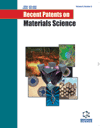- Home
- A-Z Publications
- Recent Patents on Materials Science
- Previous Issues
- Volume 11, Issue 2, 2018
Recent Patents on Materials Science - Volume 11, Issue 2, 2018
Volume 11, Issue 2, 2018
-
-
Adsorptive Remediation of Heavy Atoms Contaminated Water Using Graphene Oxide: A Review
More LessAuthors: Tanveer A. Tabish, Fayyaz A. Memon, Hasan Hayat and Shaowei ZhangThe use of graphene-related two-dimensional (2D) materials in water treatment have gained tremendous attention in diminishing the worldwide water scarcity owing to their unique water transport properties, high surface area, excellent mechanical strength, non-corrosive features and tunable surface chemistry as discussed in patents. Graphene oxide (GO) has also received extensive coverage in water treatment proce Read More
-
-
-
In situ Synthesis of Ruthenium Supported on Ginkgo Leaf-Derived Porous Carbon for H2 Generation from NH3BH3 Hydrolysis
More LessAuthors: Nianpu Li, Chongyang Gao, Shujun Qiu, Hailiang Chu, Yongjin Zou, Cuili Xiang, Huanzhi Zhang, Erhu Yan, Fen Xu and Lixian SunBackground: Hydrogen is considered a clean energy carrier. Ammonia-borane (AB, NH3BH3) has been attracted considerable attention as a potential chemical hydrogen storage material. Objective: To improve the catalytic activity for hydrogen production of AB hydrolysis, to develop a catalyst with high activity is urgently needed. Method: The patents relating to the catalytic hydrolysis of AB for hydrogen production are Read More
-
-
-
The Influence of Ammonia Addition on the Surface Characteristics of Fe3O4/Carbon Nanoparticles in Submerged Arc Discharge
More LessAuthors: Teguh E. Saraswati, Indah Retnosari, Ikrima Nur Hayati, Amalia Amalia and Sri HastutiBackground: Fe3O4/Carbon nanoparticles have attracted attention in a wide variety of applications. To make them more biocompatible, surface modification is required. A submerged arc discharge as a common technique has been reported in recent patents and research articles for carbonbased nanomaterials synthesis and possibly applied for those material modifications at once. However, the influence of liquid me Read More
-
-
-
Novel Carbon Black-Halloysite Nanotube Reinforced NBR-PVC Hybrid Oil Seals for Automotive Applications
More LessAuthors: K. Senthilvel and B. PrabuBackground: The current scenario requires the rubber industries to develop cheaper and environmentally friendly fillers as an alternative to the conventionally used carbon black filler. Objective: This study aims at developing new NBR/PVC oil seals for automotive applications using CB-HNT hybrid fillers. Method: In various patents, FESEM and XRD were used to study the microstructure of the samples. Tensile and tear tests w Read More
-
-
-
Optical and Magnetic Properties of Cobalt Ions Doped Calcium Phosphate by Ultrasonication
More LessAuthors: P. Kurinjinathan and K. T. ArulBackground: Hydroxyapatite (HAp) is a remarkable member of the calcium phosphate family. It resembles natural bone in both structure and chemical composition. Owing to its bioactive and chemical properties, it has been used as a biocompatible osteogenesis and energy materials as discussed in patents. Objective: To study the structural, optical properties and magnetic properties of hydroxyapatite and cobalt ions dop Read More
-
-
-
Spectroscopic Properties of NiO, PbO, CaO and MgO Ionic Crystals Synthesized by Ball Milling Method
More LessAuthors: G. R. Kumar, D. Baba Basha, K. C. B. Naidu, S. Ramesh and K. SrinivasBackground: The metal oxide (M-O) ionic crystals such as NiO, PbO, CaO and MgO can be synthesized via mechanical alloying method apart from the solution techniques whose structures and spectroscopic properties are studied in recent patents. Objectives: This work deals with the synthesis and characterization of NiO, PbO, CaO and MgO using mechanical ball milling method. Method: The ball miller, X-ray diffractometer, sca Read More
-
-
-
High Strength Lightweight Glass-Ceramics Fabricated Using Waste Flyash as Main Raw Material
More LessHigh strength lightweight glass-ceramics were fabricated by using waste flyash as main raw material. The effects of the utilization rate of the fly ash, nucleation agents, and sintering temperature on the properties of the glass-ceramics were studied. The flyash utilization rate as high as 70% was achieved in realizing an optimal glass-ceramics property at a sintering temperature of 1300 °C. When nucleation agents of Fe2O3 ( Read More
-
Most Read This Month
Article
content/journals/mats
Journal
10
5
false
en


